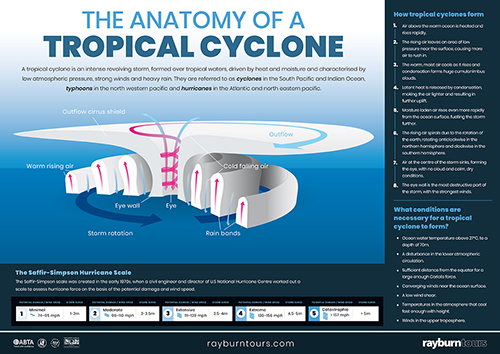
At Rayburn Tours, we’re all about supporting young people’s learning which is why we take the time to create fantastic free resources for you to use in lessons. The latest resource in the series covers The Anatomy of a Tropical Cyclone.
A tropical cyclone is an intense revolving storm, formed over tropical waters, driven by heat and moisture and characterised by low atmospheric pressure, strong winds and heavy rain. They are referred to as cyclones in the South Pacific and Indian Ocean, typhoons in the north western pacific and hurricanes in the Atlantic and north eastern pacific.
How tropical cyclones form
- Air above the warm ocean is heated and rises rapidly.
- The rising air leaves an area of low pressure near the surface, causing more air to rush in.
- The warm, moist air cools as it rises and condensation forms huge cumulonimbus clouds.
- Latent heat is released by condensation, making the air lighter and resulting in further uplift.
- Moisture laden air rises even more rapidly from the ocean surface, fuelling the storm further.
- The rising air spirals due to the rotation of the earth, rotating anticlockwise in the northern hemisphere and clockwise in the southern hemisphere.
- Air at the centre of the storm sinks, forming the eye, with no cloud and calm, dry conditions.
- The eye wall is the most destructive
What conditions are necessary for a tropical cyclone to form?
- Ocean water temperature above 27°C, to a depth of 70m.
- A disturbance in the lower atmospheric circulation.
- Sufficient distance from the equator for a large enough Coriolis force.
- Converging winds near the ocean surface.
- A low wind shear.
- Temperatures in the atmosphere that cool fast enough with height.
- Winds in the upper troposphere.
The Saffir-Simpson Hurricane Scale
The Saffir-Simpson scale was created in the early 1970s, when a civil engineer and director of U.S National Hurricane Centre worked out a scale to assess hurricane force on the basis of the potential damage and wind speed.




